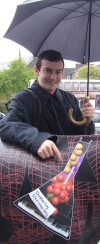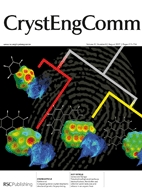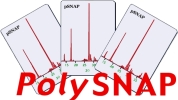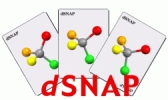Introduction
Find out what I'm up to in my post-academic career at www.gbarr.info
Until March 2010, I
was a post-doctoral research fellow in the Theoretical
Crystallography group, part of WestCHEM at the Department of
Chemistry,
University of Glasgow. The group was led by Professor Chris
Gilmore. I have since left for pastures new, but maintain close links to the Department
 Along
with Andy
Parkin, I am jointly
responsible for Chem-moo-stry
- the Chemistry Cow! A unique member
of the 2006 Edinburgh Cow
Parade, Chem-moo-stry.org is
a scientific bovine,
interested in explaining science through art – displaying some of
the modern, cutting-edge chem-moo-stry research from
the cow-laborations
between the Scottish Universities forming ScotCHEM.
Along
with Andy
Parkin, I am jointly
responsible for Chem-moo-stry
- the Chemistry Cow! A unique member
of the 2006 Edinburgh Cow
Parade, Chem-moo-stry.org is
a scientific bovine,
interested in explaining science through art – displaying some of
the modern, cutting-edge chem-moo-stry research from
the cow-laborations
between the Scottish Universities forming ScotCHEM.
After the public Cow Parade ended, Cow #64 was brought back to
Glasgow
University's Chemistry Department, restored and on display after being unveiled
by Prof. Anne Glover, the Chief Scientific Advisor for
Scotland. She has now moo-ved on to be displayed at the Glasgow Science Centre.
I was also involved in helping with IT support in the
Chemistry Department, in particular working on special projects,
including the new Chemistry Plasma Information Screen
System, and other
database and web-related systems.
Research
Interests
I developed software that applies numerous types of cluster
analysis and other multivariate statistical methods to problems in
crystallography and chemistry, and use computer graphics to display the
results in an intuitive and easy-to-interpret manner.

PolySNAP
is a software package designed to match and analyse powder diffraction
patterns utilising their full profiles. The use of the full-profile
allows for more flexible and accurate identification of samples, even
when data quality is low or preferred orientation effects are
significant.
The software provides an easy to
use interface to several powerful and novel statistical methods to rank
patterns in order of their similarity to any selected sample, allowing
unknowns to be quickly identified. In quantitative mode, given a
mixture pattern and potential pure phase patterns, it can identify
which patterns are in the mixture, and quantify their proportions
quickly and easily using a non-Rietveld based approach.
Selected Recent
Publications
Configurational and conformational classification of pyranose sugarsCollins, A., Parkin, A., Barr, G., Dong, W., Gilmore, C.J., and Wilson, C.C.
Acta. Cryst. B64, 57-65
Using the Cambridge Structural Database to validate powder structuresBarr, G., Dong, W., Gilmore, C.J, Kern, A., Parkin, A., and Wilson, C.C.
Z. Kristallogr. Suppl. 26 (2007) 209-214
A Quick Method for the Quantitative Analysis of Mixtures. 1. Powder X-Ray DiffractionDong, W., Gilmore, C., Barr, G., Dallman, C., Feeder, N., and Terry, S.
J. Pharm. Sci., (2007), 10.1002/jps.21142
Using
cluster analysis to study transition-metal geometries: four-coordinate
complexes with two salicylaldiminato or related ligands
Parkin, A., Barr, G., Collins, A., Dong, W., Gilmore, C.J.,
Tasker, P. and Wilson, C. C.
Acta Cryst. (2007).
B63,
612-620

Parkin,
A., Barr, G., Dong, W., Gilmore, C.J., Jayatilaka, D., McKinnon, J.J.,
Spackman, M.A, and Wilson, C.C. CrystEngComm,
(2007) 8,
613-714
-
Featured in
the July 2007
issue of RSC
Chemical
Science
-
Cover Article for August 2007 issue of CrystEngComm.
Collins,
A., Barr, G., Dong, W., Gilmore, C.J., Middlemass, D.S., Parkin, A. and
Wilson, C. C. Acta Cryst,
(2007). B63,
469-476
Identifying
structural motifs in inter-molecular contacts using cluster analysis
Part
2. Interactions of carboxylic acids with secondary amides
Collins,
A., Parkin, A., Barr, G., Dong, W., Gilmore, C.J. and Wilson, C. C.
CrystEngComm,
(2007).
9,
222 - 227
A
full list of publications may be found here.
Background
Ph.D.
in Chemistry in 2003 at the University of Glasgow. First degree was
also from Glasgow - an M.Sci. in Chemistry in 1999.
Undergraduate Fourth Year project was with Dr. Paul Mallinson on charge
density studies of weak hydrogen bonds.
My interests include
books, architecture and history (especially cinemas and cinema
architecture, Glasgow and the
West End - see the
personal links
on the right), and other more normal
stuff.
 Along
with Andy
Parkin, I am jointly
responsible for Chem-moo-stry
- the Chemistry Cow! A unique member
of the 2006 Edinburgh Cow
Parade, Chem-moo-stry.org is
a scientific bovine,
interested in explaining science through art – displaying some of
the modern, cutting-edge chem-moo-stry research from
the cow-laborations
between the Scottish Universities forming ScotCHEM.
Along
with Andy
Parkin, I am jointly
responsible for Chem-moo-stry
- the Chemistry Cow! A unique member
of the 2006 Edinburgh Cow
Parade, Chem-moo-stry.org is
a scientific bovine,
interested in explaining science through art – displaying some of
the modern, cutting-edge chem-moo-stry research from
the cow-laborations
between the Scottish Universities forming ScotCHEM.






